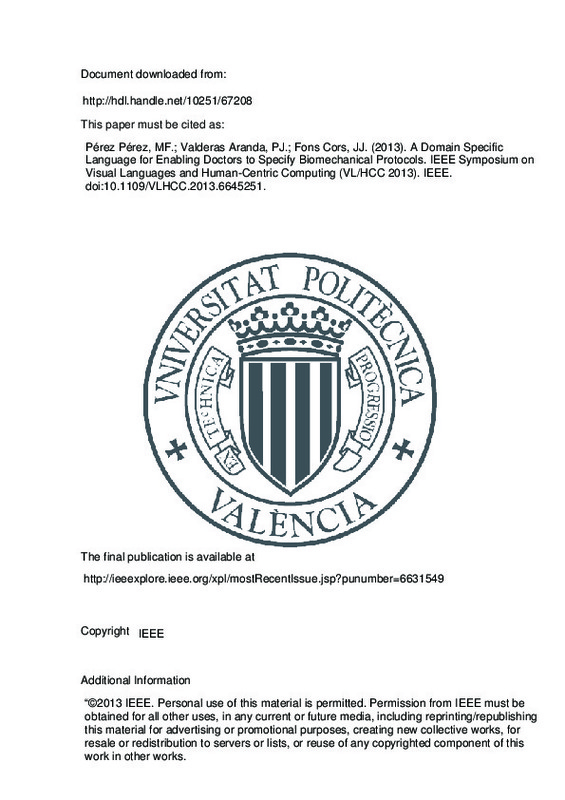JavaScript is disabled for your browser. Some features of this site may not work without it.
Buscar en RiuNet
Listar
Mi cuenta
Estadísticas
Ayuda RiuNet
Admin. UPV
A Domain Specific Language for Enabling Doctors to Specify Biomechanical Protocols
Mostrar el registro sencillo del ítem
Ficheros en el ítem
| dc.contributor.author | Pérez Pérez, María Francisca
|
es_ES |
| dc.contributor.author | Valderas Aranda, Pedro José
|
es_ES |
| dc.contributor.author | Fons Cors, Joan Josep
|
es_ES |
| dc.date.accessioned | 2016-07-06T10:55:12Z | |
| dc.date.available | 2016-07-06T10:55:12Z | |
| dc.date.issued | 2013-09 | |
| dc.identifier.issn | 1943-6092 | |
| dc.identifier.uri | http://hdl.handle.net/10251/67208 | |
| dc.description | “©2013 IEEE. Personal use of this material is permitted. Permission from IEEE must be obtained for all other uses, in any current or future media, including reprinting/republishing this material for advertising or promotional purposes, creating new collective works, for resale or redistribution to servers or lists, or reuse of any copyrighted component of this work in other works. | es_ES |
| dc.description.abstract | New technologies are entering medical practice at an astounding pace. However, these technologies often cause to doctors learn and use difficulties. Then, doctors require assistance of a biomedical engineer. This is currently happening in a local hospital that has new technology to analyze biomechanical protocols in patients. Protocols are used to measure performances and identify changes in human body movements and muscles. Doctors are neither familiar with the concepts nor tools used, so biomedical engineers carry out descriptions of protocols rather than doctors. In this paper, we present the design of a domainspecific language that enables doctors to specify biomechanical protocols by addressing learning barriers (using design patterns). We also make doctors’ descriptions compatible with the existing tools, and we also support legacy biomedical descriptions (combining meta-modeling and model transformations). | es_ES |
| dc.description.sponsorship | This work has been developed with the support of Ministerio de Ciencia e Innovación (MICINN) under the project EVERYWARE TIN2010-18011 and cofinanced with European Regional Development Fund (ERDF). | es_ES |
| dc.format.extent | 6 | es_ES |
| dc.language | Inglés | es_ES |
| dc.publisher | IEEE | es_ES |
| dc.rights | Reserva de todos los derechos | es_ES |
| dc.subject.classification | CIENCIAS DE LA COMPUTACION E INTELIGENCIA ARTIFICIAL | es_ES |
| dc.subject.classification | LENGUAJES Y SISTEMAS INFORMATICOS | es_ES |
| dc.title | A Domain Specific Language for Enabling Doctors to Specify Biomechanical Protocols | es_ES |
| dc.type | Comunicación en congreso | es_ES |
| dc.identifier.doi | 10.1109/VLHCC.2013.6645251 | |
| dc.relation.projectID | info:eu-repo/grantAgreement/MICINN//TIN2010-18011/ES/CONSTRUCCION DE SOFTWARE ADAPTATIVO PARA LA INTEGRACION DE PERSONAS, SERVICIOS Y COSAS USANDO MODELOS EN TIEMPO DE EJECUCION/ | es_ES |
| dc.rights.accessRights | Abierto | es_ES |
| dc.contributor.affiliation | Universitat Politècnica de València. Departamento de Sistemas Informáticos y Computación - Departament de Sistemes Informàtics i Computació | es_ES |
| dc.description.bibliographicCitation | Pérez Pérez, MF.; Valderas Aranda, PJ.; Fons Cors, JJ. (2013). A Domain Specific Language for Enabling Doctors to Specify Biomechanical Protocols. IEEE. https://doi.org/10.1109/VLHCC.2013.6645251 | es_ES |
| dc.description.accrualMethod | S | es_ES |
| dc.relation.conferencename | IEEE Symposium on Visual Languages and Human-Centric Computing (VL/HCC 2013) | es_ES |
| dc.relation.conferencedate | September 15-19, 2013 | es_ES |
| dc.relation.conferenceplace | San Jose, CA, USA | es_ES |
| dc.relation.publisherversion | http://dx.doi.org/10.1109/VLHCC.2013.6645251 | es_ES |
| dc.type.version | info:eu-repo/semantics/publishedVersion | es_ES |
| dc.relation.senia | 254755 | es_ES |
| dc.contributor.funder | Ministerio de Ciencia e Innovación | es_ES |
| dc.contributor.funder | European Regional Development Fund | es_ES |







![[Cerrado]](/themes/UPV/images/candado.png)

